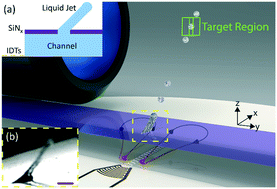Our official English website, www.x-mol.net, welcomes your
feedback! (Note: you will need to create a separate account there.)
On-demand sample injection: combining acoustic actuation with a tear-drop shaped nozzle to generate droplets with precise spatial and temporal control.
Lab on a Chip ( IF 6.1 ) Pub Date : 2019-12-19 , DOI: 10.1039/c9lc00837c Jason C Brenker 1 , Citsabehsan Devendran 1 , Adrian Neild 1 , Tuncay Alan 1
Lab on a Chip ( IF 6.1 ) Pub Date : 2019-12-19 , DOI: 10.1039/c9lc00837c Jason C Brenker 1 , Citsabehsan Devendran 1 , Adrian Neild 1 , Tuncay Alan 1
Affiliation

|
An on-demand droplet injection method for controlled delivery of nanolitre-volume liquid samples to scientific instruments for subsequent analysis is presented. We employ pulsed focussed surface acoustic waves (SAW) to eject droplets from an enclosed microfluidic channel into an open environment. The 3D position of individual droplets and their time of arrival can be precisely controlled to within 61 μs in a 500 μm square target region 40 μm wide. The continuous ejection rate of 16 000 droplets per second can be tuned to produce pulsed trains of droplets from 0 up to 357 Hz. The main benefit of this technique is its ease of integration with complex microfluidic processing steps, such as droplet merging, sorting, and encapsulation, prior to sample delivery. With its ability to precisely deliver a small quantity of fluid to a pre-defined location this technology is applicable in X-ray based molecular studies, including the rapidly expanding field of X-ray free electron lasers. Fabrication procedures for this device, the underlying forcing mechanism, the role of nozzle design, and demonstration of the performance in both continuous and on-demand modes are reported.
中文翻译:

按需进样:将声学驱动与泪滴形喷嘴结合在一起,以精确的时空控制产生液滴。
提出了一种按需滴注方法,可控制将纳升体积的液体样品输送到科学仪器中进行后续分析。我们采用脉冲聚焦表面声波(SAW)将液滴从封闭的微流体通道喷射到开放的环境中。在宽度为40μm的500μm正方形目标区域中,单个液滴的3D位置及其到达时间可以精确控制在61μs之内。可以调整每秒16000个液滴的连续喷射速度,以产生从0到357 Hz的脉冲液滴序列。该技术的主要优点是易于在样品交付前与复杂的微流体处理步骤集成,例如液滴合并,分选和封装。凭借将少量流体精确地输送到预定位置的能力,该技术适用于基于X射线的分子研究,包括快速扩展的X射线自由电子激光器领域。报告了该设备的制造程序,潜在的强制机制,喷嘴设计的作用以及在连续和按需模式下的性能演示。
更新日期:2020-02-13
中文翻译:

按需进样:将声学驱动与泪滴形喷嘴结合在一起,以精确的时空控制产生液滴。
提出了一种按需滴注方法,可控制将纳升体积的液体样品输送到科学仪器中进行后续分析。我们采用脉冲聚焦表面声波(SAW)将液滴从封闭的微流体通道喷射到开放的环境中。在宽度为40μm的500μm正方形目标区域中,单个液滴的3D位置及其到达时间可以精确控制在61μs之内。可以调整每秒16000个液滴的连续喷射速度,以产生从0到357 Hz的脉冲液滴序列。该技术的主要优点是易于在样品交付前与复杂的微流体处理步骤集成,例如液滴合并,分选和封装。凭借将少量流体精确地输送到预定位置的能力,该技术适用于基于X射线的分子研究,包括快速扩展的X射线自由电子激光器领域。报告了该设备的制造程序,潜在的强制机制,喷嘴设计的作用以及在连续和按需模式下的性能演示。











































 京公网安备 11010802027423号
京公网安备 11010802027423号